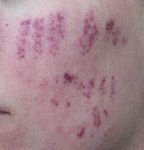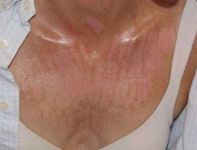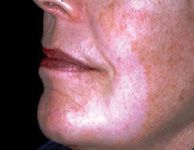- Case-Based Roundtable
- General Dermatology
- Eczema
- Chronic Hand Eczema
- Alopecia
- Aesthetics
- Vitiligo
- COVID-19
- Actinic Keratosis
- Precision Medicine and Biologics
- Rare Disease
- Wound Care
- Rosacea
- Psoriasis
- Psoriatic Arthritis
- Atopic Dermatitis
- Melasma
- NP and PA
- Skin Cancer
- Hidradenitis Suppurativa
- Drug Watch
- Pigmentary Disorders
- Acne
- Pediatric Dermatology
- Practice Management
- Prurigo Nodularis
- Buy-and-Bill
Article
Laser & Light complications: Cautious treatment, candid disclosures are key
Avoiding laser and light complications requires practicing universal safety precautions, because complications can happen even with the most experienced equipment operators, an expert says.

Key Points
National report - Even when performed by the best practitioners, laser and light treatments can occasionally lead to complications, an expert says. Minimizing them requires following universal safety precautions, and to keep patients satisfied, doctors must disclose all risks during the consent process, he says.
"Just as physicians practice universal safety precautions to prevent needle sticks in their offices, dermatologists should practice universal laser safety precautions," says Jeffrey S. Dover, M.D., associate clinical professor, department of dermatology, Yale Medical School, and a director of SkinCare Physicians, Chestnut Hill, Mass.
These precautions include using conservative techniques, applying cooling technologies wherever possible, and protecting the eyes of the physician, nursing staff and patients.
"If one doesn't explain these risks beforehand in an informed consent - in writing and verbally - one is potentially at legal risk," he says.
OPERATOR CONCERNS
The biggest concern for laser operators and nursing staff, on the other hand, is eye damage stemming from improper use of protective goggles, Dr. Dover says.
"It usually happens to experts," he says, "because novices are afraid to take off their goggles. It happens to people who think they know better - they may peek under the goggles, especially if they're presbyopic, to see little bit better."
"With the ultra short-pulse lasers," Dr. Dover says, "we actually get tissue splattering, which cannot be picked up with the vacuum."

To avoid purpura after pulsed-dye laser treatments, he says, "Drop your fluence and raise the pulse duration." Physicians also must remember - and inform patients - that edema occurs commonly after large treatments with pulsed-dye lasers, intense-pulsed light (IPL) or pulsed-green lasers, Dr. Dover says.
"Make sure that patients know this is a possibility, especially when doing a lot of pulses," he says.
TREATING COMPLICATIONS

He recommends applying ice immediately after treatment for 10 minutes, then 10 minutes per hour for the rest of the treatment day. Sleeping in an elevated position also reduces swelling, Dr. Dover says.
"But some people are prone to swelling no matter what the physician does," he says.
Taking accurate patient histories also can help reduce laser side effects, he says.






